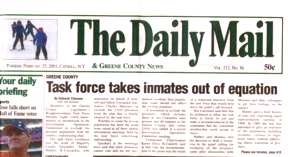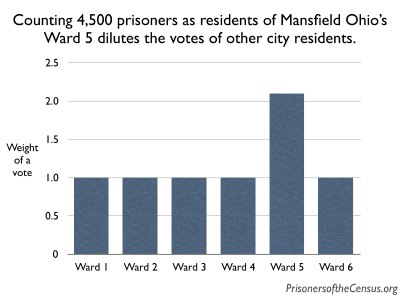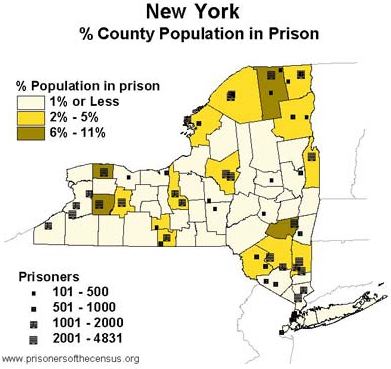by Peter Wagner,
October 27, 2003
There are 86 unmarried men for every 100 unmarried women in the United States. The ratio will vary between neighborhoods, cities, regions and states from a variety of influences on the statistic. Some are the reflections of women’s longevity, different cultural ideas about marriage, and some are the result of social and economic demographics like the concentration of young people.
The disparity between states is somewhat small, ranging from Alabama and Rhode Island at 79 unmarried men to 100 unmarried women, to Alaska at 114 unmarried men per 100 unmarried women. (Alaska is a very small state that has a lot of industries that rely on imported male workers. The next state is Nevada at 103 unmarried men per 100 unmarried women.)
The county disparity is huge, ranging from 53.8 to 362 unmarried men per 100 unmarried women. The Census collects marital status data because it helps communities plan for social services and future growth. While relatively useful for some purposes on the state level, this data is more difficult to use on the county or town level because the Census includes “special populations” of prisoners and soldiers — which tend to be male — in with the local community rather than at their actual homes.
Continue reading →
by Peter Wagner,
October 20, 2003
Much of the research on this website uses county-of-conviction as a proxy for a prisoner’s home residence because this data is more frequently available. Although most Departments of Correction gather residence data, they frequently only publish county-of-conviction data.
The general equivalency of the county of conviction and residence datasets can be proven in North Carolina, where the Department of Corrections publishes both sets of information. Analysis shows that the two figures are substantially the same, other than a small number (5%) of prisoners with an out-of-state residence.
Although correcting the Census dataset for redistricting purposes will require the precise address information in the residence files, county-of-conviction data is sufficient to show the necessity of abandoning the Census’s usual residence rule: In most states, prisoners are convicted in a small number of urban counties and incarcerated — where the Census currently counts them — in other counties.
by Peter Wagner,
October 13, 2003
Unfortunately, counting disenfranchised residents for purposes of mis-representation in the legislature is nothing new.
At the founding of the United States, the white population in the South was much smaller than that in the North. In a huge compromise, the original U.S. Constitution allowed the Southern states to count their Black slaves as 3/5ths of a white person. The slaves couldn’t vote, so the slaveowners got to “represent” this captive population in Congress and the Electoral College.
The result? Thanks to its added population, for 32 of the first 36 years of the country, the President was a slave-holder from the otherwise small state of Virginia. Artificially boosting the political power of the South created a national stalemate that prevented the creation of a democratic solution to the slavery problem. What might have been resolved peacefully in the 1790s became the Civil War in the 1860s.
Today, a similar democratic and economic impasse presents itself in the debate over crime control policy. As the economy constricts and state budgets contract, it is absolutely essential that our political structure be responsive to changing needs of the people.
Would a democratically constituted legislature support expensive prisons over proven-effective drug treatment? Counting our population at their true residences and apportioning political power accordingly would be a great way to find out.
by Peter Wagner,
October 6, 2003
It comes as no surprise that prisoners resemble the communities from which they come, and that prison staff resemble the communities that host the prisons. But what may be a surprise is just how different these two groups are.
According to our recent study, more than half of all prisoners are Black, but only 20% of the prison jobs are held by Black staff. Only 64 prisons in the country have been able to hire Black staff in proportion to the number of Black prisoners; and not a single one of these prisons is located outside the South or the urban cities of the North.
Despite a concerted effort by prison administrators to increase staff diversity, prison staff remain overwhelming white because the prisons themselves are increasingly being built in rural areas rather than in the urban and predominantly minority areas from which most prisoners originate.
This racial disparity between prisoners and staff is another way of illustrating that prisoners tend to come from very different communities than the prisons are physically located in. Counting prisoners in their true communities would give us a more accurate picture of the size and needs of all our communities.
See: Peter Wagner and Rose Heyer, AlterNet, September 25, 2003.
by Peter Wagner,
September 29, 2003
Mansfield, Ohio is a small city with 6 city council wards of approximately 8,600 residents each. The problem? Two large prisons (Mansfield Correctional Institution and Richland Correctional Institution) are both in the 5th Ward and their populations were counted as residents of the ward.
The City’s law director advocated for a redistricting plan that would at least split the prisons into two different districts, complaining that “Deanna [Torrence of the 5th Ward] is only representing 3,000 people (who actually can vote).” The City decided to keep the districts as-is.
The best solution for the city would have been to exclude the prisoners from the redistricting process as the majority of the prisoners are from outside Mansfield and its Ward 5. Only 1.26% of Ohio’s prisoners are from Richland County (564 prisoners), with a smaller portion being from Mansfield and an even smaller portion from Ward 5.
It makes no sense to use Census counts of state prisoners to divide up political power within the City of Mansfield. Of course, the best solution would be for the Census to count prisoners at home, not at temporary prisons.
Sources: Linda Martz, Taxpayers before wards, Mansfield News Journal (Mansfield, OH) November 26, 2002, p. 6A; U.S. Census, Ohio Department of Corrections and Rehabilitation.
by Peter Wagner,
September 22, 2003
Counting prisoners as residents of the prison town can skew the balance of political power within a rural community as well. As I wrote in Bogus data pumps up the rural population, the reported population of many rural counties with prisons can be significantly changed by as much as 5 or 10% as a result of counting mostly-urban prisoners at the prison. In counties with a legislative form of government, including the prisoners in the base population can significantly boost the weight of a vote in the prison town while diluting the weight of a vote in other portions of a county.
In Greene County NY, the county legislature proposed to include prisoners in the count. The two prisons in Coxsackie in the northeast corner of the county amounted to 6% of the county’s population. Of course, the prisoners can’t vote and few if any are from Greene County. Including the prisoners would have resulted in the town of Coxsackie getting 48% more representation in the local legislature than it was entitled to.

At the urging of residents elsewhere in the county, the Greene County legislature decided to change from previous practice and exclude the prisoners from the count. This was the correct thing to do. The change did not hurt the ability of the prisoners to get representation in local government (as they were not residents of Greene County in the first place), and it brought the principle of “one person one vote” to the local county legislature.
Unfortunately, this was not the practice everywhere in New York, and the diversity of approaches shows that contrary to assumption, counties are not obligated to slavishly use inappropriate Census data in their redistricting. According to a survey distributed by Saint Lawrence County, 14 counties included prisoners in their redistricting and 9 excluded them. (Ten of the prison counties did not respond.)
See also Exclude prisoners from local redistricting submitted to Daily Freeman, Greene County, New York, February 3, 2003.
by Peter Wagner,
September 15, 2003
The presence of a prison in a rural area can have a huge impact on Census Bureau statistics about the town or county. In a number of counties in New York, prisons can make up more than 2% of the county’s population, and in the case of Franklin County, prisoners constitute almost 11% of the population reported to the Census.
by Peter Wagner,
September 8, 2003
In 1894, Michael Cady tried to register to vote using his address at the Tombs Jail in New York City. Jail inmates are allowed to vote, but he was convicted for illegal registration because the NY Constitution says that
“no person shall be deemed to have gained or lost a residence, by reason of his presence or absence … while confined in any public prison.”
The prosecution’s theory that that while Cady was allowed to vote, he could not vote in the prison district. Even through Cady was planning on staying at the Tombs forever, Cady must have — the prosecution argued — lived somewhere else before.
The highest court in New York agreed:
“The Tombs is not a place of residence. It is not constructed or maintained for that purpose. It is a place of confinement for all except the keeper and his family, and a person cannot under the guise of a commitment … go there as a prisoner, having a right to be there only as a prisoner, and gain a residence there.”
If calling your jail cell your residence gets you sent to prison, shouldn’t it be illegal for rural legislators to call prisoners their “constituents”?
Read more about Michael Cady in Importing Constituents: Prisoner and Political Clout in New York.
by Peter Wagner,
September 1, 2003
“On April Fool’s Day this year state prison wardens gave more than 5,600 inmates time off from their hourly-wage jobs to fill out their census forms. The wardens know how many inmates they have, of course, but only the prisoners know the answers to the more detailed questions posed in the national headcount. So each inmate who cooperated was paid $1…
“A dollar may not sound like much of an incentive, but prison wages are often less than 75 cents an hour….
“The census, as Minnesotans were repeatedly reminded last spring, means money for basic services. The detailed demographic information people offer up on their census forms every ten years translates into federal dollars to help their communities pay for everything from affordable housing to road repair. Prisoners, however, don’t get counted as residents of their former neighborhoods. Instead, the census adds them to the populations of the communities where they are serving time.
See: Prison Math by Meleah Maynard in City Pages, October 25, 2000.
by Peter Wagner,
August 25, 2003
Almost 30 percent of new residents who came to Upstate New York in the 1990s didn’t make the trip by choice, and they didn’t move into subdivisions or houses on secluded cul-de-sacs. They were inmates making their new homes in prison cells, according to a new report on population trends in upstate.
–Gannet News Service, August 24, 2003
That was perhaps the most striking statistic in a new report by the Brookings Institution documenting the stagnation of much of upstate, which grew in population just 1.1 percent in the ’90s.
Counting prisoners in their home community would avoid this type of confusion that skews Census statistics.
See our New York maps showing how counting urban prisoners as residents of rural prison towns undermines the accuracy and utilitity of Census data.






